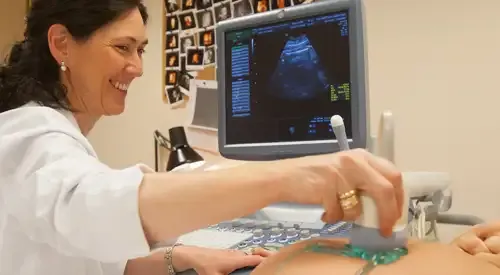Gynecological Cancer
"It is possible to reduce the risk by avoiding hormone replacement therapy with estrogen alone, maintaining a healthy weight, daily physical exercise and a thorough control by your gynecologist in case of family history, risk factors, taking tamoxifen or any genital bleeding".
DR. JOSÉ ÁNGEL MÍNGUEZ
CODIRECTOR. GYNAECOLOGY AND OBSTETRICS DEPARTMENT

Gynecological cancer is one of the most common cancers seen in women and can be located anywhere in the female gynecological system: ovary, uterus, cervix, etc.
Some types of gynecological cancer are asymptomatic or produce symptoms that may be related to other pathologies, even those that are non-gynecological (digestive, urinary, etc.). Therefore, regular checkups with a gynecologist are important. The earlier the cancer is detected, the better the chances of recovery.
Our department offers individualized, state-of-the-art, multidisciplinary treatment.
Our team of specialists works quickly, coordinating their efforts to provide patients with the highest levels of service. The department comprises gynecologists specializing in oncological diseases, medical oncologists, radiation oncologists and pathologists.

A PERSONALIZED MEDICINE
Second Opinion,
peace of mind
Request a second opinion from our professionals with great experience in the diagnosis and treatment of oncological diseases
In 3 days, without leaving home.
What are the symptoms of gynecological cancer?
- Ovarian cancer. There are no specific symptoms of ovarian cancer, and it is often confused with symptoms seen in the digestive system and bladder, particularly if symptoms are persistent.
The most common symptoms include abdominal swelling, a bloated sensation, poor digestion, constipation or diarrhea, and a more frequent urge to urinate. - Endometrial cancer. Symptoms include any type of genital bleeding, abnormal vaginal discharge, and pelvic pain.
- Cervical cancer. Mostly asymptomatic, particularly in the early stages. May be associated with bleeding following intercourse, between periods or during menopause. Bloody or foul-smelling vaginal discharge may present in some cases.
Do you have any of these symptoms?
You may have a gynecological cancer
Prevention of gynecological cancer
Early diagnosis is sometimes the best prevention.
Ovarian cancer. There is no reliable way of preventing this form of cancer; as such, early-stage diagnosis where the disease is more treatable is considered the best form of prevention. Transvaginal ultrasound plays a key role in high-risk or symptomatic patients.
Endometrial cancer. Endometrial cancer cannot be prevented, but risk can be reduced by avoiding estrogen-only hormone replacement therapy, maintaining a healthy weight and doing daily physical exercise. Keeping up with gynecological checkups will reduce your risk if you have a genetic or personal history of risk, or if you take tamoxifen; you should see your gynecologist as soon as possible after any genital bleeding following menopause.
Cervical cancer. Prevention should begin within three years of beginning sexual relations at any age or no later than 21. Cervical and vaginal cytology (Pap test, or smear) detects abnormal cells where cancer has not yet developed. The HPV test determines whether you have this infection and, if so, what type is present.
What are the risk factors?
Risk factors for gynecological cancers include hereditary factors or having previously suffered from breast cancer. There is often an additional risk following menopause and in women who have not had children.
Other causes are obesity and estrogen-only hormone replacement therapy.
For cervical cancer, risk increases in women who have a large number of sexual partners, those who become sexually active at a younger age (under 18), those with a compromised immune system and smokers; above all, women infected with HPV have a high risk.
How are gynecological cancers diagnosed?

Ovarian cancer
- Clinical examination.
- Transvaginal or transrectal ultrasound. These tests have an extremely high diagnostic accuracy.
- Tumor markers in the blood, especially CA-125.
- Imaging tests: CT, abdominal ultrasound, MRI, PET–CT.
- Surgical exploration: confirm and treat any disease located in the abdomen.
Endometrial cancer
- Clinical examination.
- Transvaginal or transrectal ultrasound to look at the characteristics and thickness of the endometrium.
- Endometrial cytology: a sample is taken from inside the uterus during the appointment and is used for orientation purposes.
- Endometrial biopsy during hospital consult: sample of endometrium extracted. No anesthesia required.
- Endometrial curettage: involves removal of a larger sample of endometrium. Performed under anesthesia.
- Hysteroscopy: procedure used to view the uterine cavity using a camera, usually performed during a hospital visit. Endometrial biopsy can be performed in a targeted manner on any suspicious areas while carrying out the hysteroscopy.
Cervical cancer
- Clinical examination, including inspection and palpation of the cervix. Colposcopy (with magnified view) helps to visualize lesions that are not visible to the naked eye.
- Cytology.
- Biopsy of any suspicious area, during a hospital visit; no anesthesia is required. May also be performed with an electric scalpel during a hospital visit, in which case local anesthesia is used.
- Conization: a cone-shaped biopsy allowing for a more comprehensive study of the lesion than a conventional biopsy.
How are gynecological tumors treated?
The scope of gynecological oncological pathology includes cancer of the vulva, vagina, cervix, endometrium (womb) and ovaries. All preinvasive conditions (vulvar, vaginal or cervical dysplasia) are also treated.
Mammary pathologies are also included in the field of oncological gynecology. However, at our center, patients are treated by a medical team dedicated specifically to this area (Mammary Pathology Area).
Patients commonly begin medical, surgical or radiotherapy treatment within just a few days.
- Ovarian cancer is treated primarily through surgery and chemotherapy.
- Endometrial cancer is treated with surgery, radiation therapy, chemotherapy and hormone therapy.
- Cervical cancer, in cases where it is not yet invasive (high-grade intraepithelial lesion or in situ carcinoma), it may be treated through conization or hysterectomy.
What clinical trials do we have on Gynecological cancer?
Proton therapy for cancer
Proton therapy is the most precise external radiotherapy modality, providing better distribution of radiation dose and therefore less irradiation of healthy tissues.
The Proton Therapy Unit of the Cancer Center Clínica Universidad de Navarra in its Madrid headquarters is the most advanced in Europe and the first in a Cancer Center, with all its healthcare, academic and research support.
Where do we treat it?
IN NAVARRE AND MADRID
The Gynecologic Cancer Area
of the Cancer Center Clínica Universidad de Navarra
The Gynecologic Cancer Area is a multidisciplinary unit focused on the treatment and research of tumors of the female genital tract.
We have professionals of recognized national and international prestige, considered opinion leaders in their field, who over the years have formed a team that places the patient at the center of its activity.
What diseases do we treat?
- Ovarian cancer
- Uterine or endometrial cancer
- Uterine cervical cancer
- Vaginal tumors
- Vulvar tumors
- Gestational trophoblastic disease

Why at the Clinica?
- High surgical specialization.
- Focused on the patient.
- State-of-the-art diagnostic and therapeutic technology.
- Research and clinical trials to offer the most innovative treatments.
























